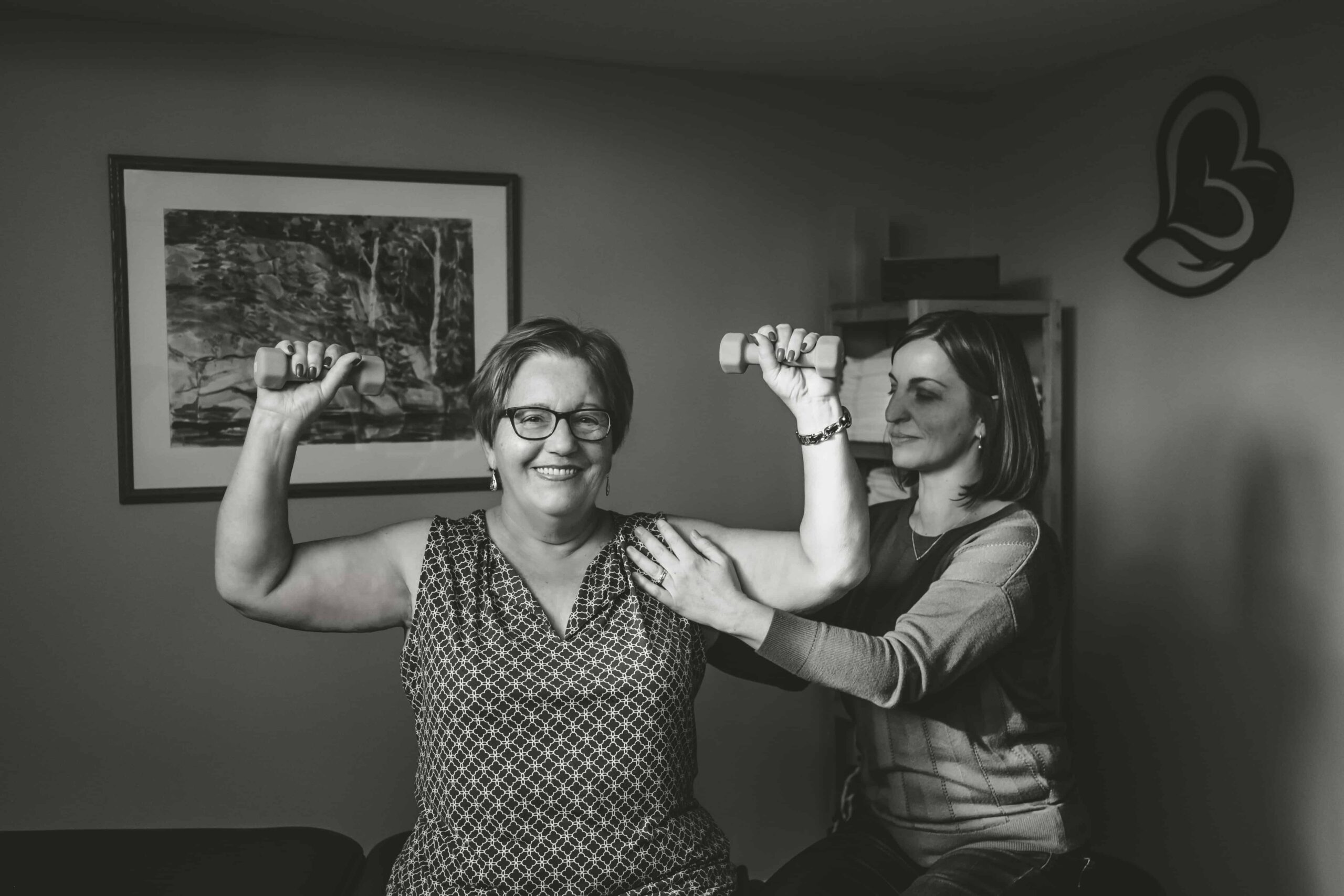Have you been following this series on lymphedema?
Why a 4-part Series on Lymphedema?
“How do I prevent lymphedema?”
In my nearly 13 years of working in cancer rehabilitation, this continues to be one of the most common questions I get from my clients. Unfortunately, this question is often fuelled by fear and anxiety that has, in part, been created by the shocking amount of misinformation and extreme generalizations created by internet sites showing pictures of “worst-case scenarios.”
Lymphedema Prevention vs Risk Reduction
I’m going to start by dispelling a huge myth, which the internet has unfortunately reinforced for decades.
You cannot “prevent” lymphedema.
“Prevention” implies that you are in complete control and can stop it from happening; it implies that it is “your fault” if you develop lymphedema after cancer treatment. This is absolutely not true! There are factors that you cannot control, such as how many lymph nodes were removed during surgery and whether or not you had radiation (especially to the lymph nodes). These treatments were necessary for your cancer treatment but do make permanent changes to your lymphatic system.
What we can do, however, is reduce your lymphedema risk…
… through the knowledge you’ve gained in the previous blogs, in addition to the important information we’re about to discuss next.
Knowing your Lymphedema Risk:
What We Know for Sure
There are some risk factors that we do know for sure, based on solid scientific evidence. Put together, these factors are helpful in estimating your risk of developing lymphedema and helps guide you on ways you can reduce your lymphedema risk. These risk factors can be divided into 2 categories: (cancer) Treatment-related and Non-treatment related factors.
Treatment-Related Factors
(i.e. Beyond your control)
Mostly in your control)
Lymph node dissection (in the armpit, groin or neck)
Obesity (Body Mass Index over 30)
Sentinel lymph node biopsy (lower risk)
Cellulitis (infection in the at-risk area)
Radiation to the lymph node bed (i.e. in the armpit, groin or neck)
Immobility
3 ways to reduce your lymphedema risk:
- Get to and/or maintain a healthy body weight through a balanced diet and regular exercise
- Follow good skin care practices for the at-risk area
- Preventing cuts and wounds
- When cuts/wounds do happen, keep them clean & monitor for infection
- Seek immediate medical attention if you show signs of infection
- Stay active and strong
- Participate in a progressive cardiovascular, resistance and flexibility program
Other Lymphedema “Risk Factors”: The Jury is Still Out
This is where the evidence gets “really confusing” and there is a lot of controversy. A lot of the lymphedema research has been lower-quality evidence. Research methods have also been very inconsistent across studies, which makes larger comparisons across studies nearly impossible. Finally, there isn’t a clear consensus on the threshold to measure and diagnose lymphedema, so this can have an enormous impact on a study’s results.
Additional risk reduction guidelines are based on what we know about the anatomy and physiology of the lymphatic system. However, the 2016 International Society of Lymphedema Consensus Document stated that these guidelines “are largely anecdotal and not sufficiently investigated” and that “standard use of some of these ‘don’ts for risk reduction of lymphedema may not be appropriate.” They suggest caution in the use of these lists until “a point in the future where… [the] evidence has demonstrated more clearly specific risks and the corresponding preventative measures.”
Essentially, there’s still a lot about the lymphatic system that we don’t yet fully understand and more rigorous studies are needed.
So how do we Know What Risk Reduction Factors Might be Applicable?
My approach is for people to understand the “why’s” behind some of these possible risk factors. In other words, understand how your lymphatic system works (see part 1 and part 2) and how the buildup of multiple possible risk factors together might overload your lymphatic system.
Your Lymphatic System is Like a Bathtub
Think about your lymphatic system like a bathtub; there is a certain maximum amount it can hold before it overflows. The bathtub drain is like your lymph nodes.
Now imagine that “turning the bathtub taps on” is like anything that increases lymphatic load. Every time you turn the taps on a bit more, more water (or “load”) will be placed on your bathtub drain (aka your lymph nodes). So long as your bathtub drain can cope with the load and the tub is large enough to handle any overload to the drain, you will be fine. But if, over time, you continue to turn the taps on more and more, the drain may no longer be able to cope and the bathtub gradually begins to fill. At a certain point, the bathtub may fill up so much that it will begin to overflow…. this is lymphedema.
So, when we consider all these other factors that MAY increase the demands on our lymph system (i.e. “turn the taps on”), we need to consider that it is RARELY only one factor that will cause a problem, but is much more commonly the combination of MULTIPLE FACTORS together that, over time, may overload your lymphatic system and lead to lymphedema.
4 ways to reduce your lymphedema risk
Things that MAY increase lymphedema risk
(i.e. “turn the taps on”)
Repetitive or heavy activity that is new to you or that you haven’t done in a long time
- (e.g. Raking the yard for a day, shovelling heavy snow for the first time)
How you MIGHT help reduce your risk
(i.e. “turn the taps down” and/or “create a more efficient drain”)
In order for your body to get used to these activities, pace yourself and gradually work back into them.
- A progressive exercise and strength training program is important so your body is physically prepared for these activities.
Things that MAY increase lymphedema risk
(i.e. “turn the taps on”)
Injury or trauma to the at-risk area
How you MIGHT help reduce your risk
(i.e. “turn the taps down” and/or “create a more efficient drain”)
- Minimize injury risk where possible (e.g. wear gloves when gardening, keep skin moisturized in winter so it doesn’t crack)
- When you do have a cut or wound, keep it clean and monitor for infection.
- When you do injure yourself, seek medical attention as needed to optimize healing.
Things that MAY increase lymphedema risk
(i.e. “turn the taps on”)
Prolonged exposure to extreme temperatures
How you MIGHT help reduce your risk
(i.e. “turn the taps down” and/or “create a more efficient drain”)
- Wear warm clothing in cold weather
- Seek cool environments for a break during hot and humid days
- Minimize the length of time in hot tubs and saunas
Things that MAY increase lymphedema risk
(i.e. “turn the taps on”)
Limb constriction |
How you MIGHT help reduce your risk
(i.e. “turn the taps down” and/or “create a more efficient drain”)
- If possible, request needles, IVs and blood pressure checks be done on the unaffected side
- Avoid wearing extremely tight jewellery that is irritating
Do Not Panic!
This does NOT mean that you should panic if you need to have an injection or blood pressure check in the at-risk area; if it happens then there’s a really good chance you’re going to be completely fine. What it does mean is that it is helpful to consider these factors as parts of the whole picture. If you have multiple possible risk factors present at the same time, then you would be wise to make an educated decision about the things you choose to do (or not do) that day.
Knowledge is the key to doing what you can to reduce your risk. Seeing a health professional who is both experienced and knowledgeable of the evidence surrounding lymphedema risk can be a very helpful way to assess your specific risk and how to best reduce your risk.
Your next steps…
Click HERE for the 4th and final part of my lymphedema series: Knowing the Signs and Symptoms of Lymphedema.
Want more support to learn what YOU can do to reduce your lymphedema risk?
Disclaimer – These blogs are for general information purposes only. Medical information changes daily, so information contained within these blogs may become outdated over time. In addition, please be aware that the information contained in these blogs is not intended as a substitute for medical advice or treatment and you should always consult a licensed health care professional for advice specific to your treatment or condition. Any reliance you place on this information is therefore strictly at your own risk.





